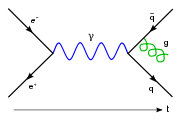Electroweak interaction
| Standard model of particle physics | ||||||||
 |
||||||||
| Standard model | ||||||||
History of...
|
||||||||
In particle physics, the electroweak interaction is the unified description of two of the four fundamental interactions of nature: electromagnetism and the weak interaction. Although these two forces appear very different at everyday low energies, the theory models them as two different aspects of the same force. Above the unification energy, on the order of 100 GeV, they would merge into a single electroweak force. Thus if the universe is hot enough (approximately 1015 K, a temperature reached shortly after the Big Bang) then the electromagnetic force and weak force will merge into a combined electroweak force.
For contributions to the unification of the weak and electromagnetic interaction between elementary particles, Abdus Salam, Sheldon Glashow and Steven Weinberg were awarded the Nobel Prize in Physics in 1979.[1] The existence of the electroweak interactions was experimentally established in two stages: the first being the discovery of neutral currents in neutrino scattering by the Gargamelle collaboration in 1973, and the second in 1983 by the UA1 and the UA2 collaborations that involved the discovery of the W and Z gauge bosons in proton-antiproton collisions at the converted Super Proton Synchrotron.
Contents |
Formulation
Mathematically, the unification is accomplished under an SU(2) × U(1) gauge group. The corresponding gauge bosons are the photon of electromagnetism and the W and Z bosons of the weak force. In the Standard Model, the weak gauge bosons get their mass from the spontaneous symmetry breaking of the electroweak symmetry from SU(2) × U(1)Y to U(1)em, caused by the Higgs mechanism (see also Higgs boson). The subscripts are used to indicate that these are different copies of U(1); the generator of U(1)em is given by Q = Y/2 + I3, where Y is the generator of U(1)Y (called the weak hypercharge), and I3 is one of the SU(2) generators (a component of weak isospin). The distinction between electromagnetism and the weak force arises because there is a (nontrivial) linear combination of Y and I3 that vanishes for the Higgs boson (it is an eigenstate of both Y and I3, so the coefficients may be taken as −I3 and Y): U(1)em is defined to be the group generated by this linear combination, and is unbroken because it doesn't interact with the Higgs.
Lagrangian
Before Electroweak Symmetry Breaking
The Lagrangian for the electroweak interactions is divided into four parts before electroweak symmetry breaking
The g term describes the interaction between the three W particles and the B particle.
The f term gives the kinetic term for the Standard Model fermions. The interaction of the gauge bosons and the fermions are through the covariant derivative.
The h term describes the Higgs field F.
The y term gives the Yukawa interaction that generates the fermion masses after the Higgs acquires a vacuum expectation value.
After Electroweak Symmetry Breaking
The Lagrangian reorganizes itself after the Higgs boson acquires a vacuum expectation value. Due to its complexity, this Lagrangian is best described by breaking it up into several parts as follows.
The kinetic term  contains all the quadratic terms of the Lagrangian, which include the dynamic terms (the partial derivatives) and the mass terms (conspicuosly absent from the Lagrangian before symmetry breaking)
contains all the quadratic terms of the Lagrangian, which include the dynamic terms (the partial derivatives) and the mass terms (conspicuosly absent from the Lagrangian before symmetry breaking)
where the sum runs over all the fermions of the theory (quarks and leptons), and the fields  ,
,  ,
,  , and
, and  are given as
are given as
 , (replace X by the relevant field, and f^(abc) with the structure constants for the gauge group).
, (replace X by the relevant field, and f^(abc) with the structure constants for the gauge group).
The neutral current  and charged current
and charged current  components of the Lagrangian contain the interactions between the fermions and gauge bosons.
components of the Lagrangian contain the interactions between the fermions and gauge bosons.
 ,
,
where the electromagnetic current  and the neutral weak current
and the neutral weak current  are
are
 ,
,
and
 and
and  are the fermions electric charges and weak isospin.
are the fermions electric charges and weak isospin.
The charged current part of the Lagrangian is given by
 contains the Higgs three-point and four-point self interaction terms.
contains the Higgs three-point and four-point self interaction terms.

 contains the Higgs interactions with gauge vector bosons.
contains the Higgs interactions with gauge vector bosons.

 contains the gauge three-point self interactions.
contains the gauge three-point self interactions.
![\mathcal{L}_{WWV}=-ig[(W_{\mu\nu}^+W^{-\mu}-W^{+\mu}W_{\mu\nu}^-)(A^\nu\sin\theta_W-Z^\nu\cos\theta_W)+W_\nu^-W_\mu^+(A^{\mu\nu}\sin\theta_W-Z^{\mu\nu}\cos\theta_W)]](/2009-wikipedia_en_wp1-0.7_2009-05/I/17e507ca8a9a9c019d3b9f5ccc8ec1a8.png)
 contains the gauge four-point self interactions
contains the gauge four-point self interactions
![\mathcal{L}_{WWVV} = -\frac{g^2}4 \left\{[2W_\mu^+W^{-\mu} + (A_\mu\sin\theta_W - Z_\mu\cos\theta_W)^2]^2 - [W_\mu^+W_\nu^- + W_\nu^+W_\mu^- + (A_\mu\sin\theta_W - Z_\mu\cos\theta_W) (A_\nu\sin\theta_W - Z_\nu\cos\theta_W)]^2\right\}](/2009-wikipedia_en_wp1-0.7_2009-05/I/95b992dfdd5c0b364636996f62688067.png)
and  contains the Yukawa interactions between the fermions and the Higgs field.
contains the Yukawa interactions between the fermions and the Higgs field.

See also
- Fundamental forces
- Formulation of the standard model
- Weinberg angle
- Particle physics
References
- ↑ Sander Bais (2005), The Equations. Icons of knowledge ISBN 0-674-01967-9 p 84
Textbooks
- Griffiths, David J. (1987). Introduction to Elementary Particles. Wiley, John & Sons, Inc. ISBN 0-471-60386-4.
- D.A. Bromley (2000). Gauge Theory of Weak Interactions. Springer. ISBN 3-540-67672-4.
- Gordon L. Kane (1987). Modern Elementary Particle Physics. Perseus Books. ISBN 0-201-11749-5.
Journal Articles
- S.F. Novaes, Standard Model: An Introduction, hep-ph/0001283
- D.P. Roy, Basic Constituents of Matter and their Interactions — A Progress Report, hep-ph/9912523
- Y. Hayato et al., Search for Proton Decay through p → νK+ in a Large Water Cherenkov Detector. Phys. Rev. Lett. 83, 1529 (1999).
- Ernest S. Abers and Benjamin W. Lee, Gauge theories. Physics Reports (Elsevier) C9, 1-141 (1973).
- J. Hucks, Global structure of the standard model, anomalies, and charge quantization, Phys. Rev. D 43, 2709–2717 (1991). [1]








![\mathcal{L}_C=-\frac g{\sqrt2}\left[\overline u_i\gamma^\mu\frac{1-\gamma^5}2M^{CKM}_{ij}d_j+\overline\nu_i\gamma^\mu\frac{1-\gamma^5}2e_i\right]W_\mu^++h.c.](/2009-wikipedia_en_wp1-0.7_2009-05/I/7e50221ac5f6c3c7de5c6ef69f07c056.png)